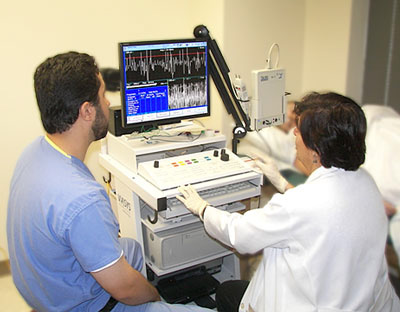How is an Intramuscular EMG Done?
A needle is inserted through the skin into the muscle. The electrical activity is detected by this needle (which serves as an electrode). The activity is displayed visually on an oscilloscope and may also be detected audibly with a speaker. After placement of the electrode(s), the patient may be asked to contract the muscle (for example, to bend the leg).
The presence, size, and shape of the waveform (the action potential) produced on the oscilloscope provide information about the ability of the muscle to respond to nervous stimulation. Each muscle fiber that contracts produce an action potential. The size of the muscle fiber affects the rate (how frequently an action potential occurs) and the size (the amplitude) of the action potential.
How do you Prepare for an Intramuscular EMG?
For adults, no special preparation is needed. For infants and children, physical and psychological preparation depends on the child’s age, behavior, and prior experience. (For instance, has the child been traumatized by another medical or dental procedure?)
Does an EMG Hurt?
No. There is some discomfort at the time of the needle insertion. For most of the patients, it is like having acupuncture. Afterward, the muscles may feel a little sore for up to a few days.
At Arizona Institute of Neurology & Polysomnography, we offer experienced, skilled medical care and the latest nonsurgical treatments for many types of chronic pain syndromes, like:
- Radiculopaties including back and neck pain,
- compression neuropathies,
- disorders related to spinal cord like
- spinal stenosis,
- cord compression,
- central canal lesions or
- degenerative diseases of the spinal cord.
An electromyogram (EMG) is a test that is used to record the electrical activity of the muscles when they are active. EMGs are used to detect abnormal electrical activity of the muscles that can occur in many diseases and conditions, including muscular dystrophy, inflammation of muscles, pinched nerves, peripheral nerve damage, amyotrophic lateral sclerosis (ALS), and others.
Want To Learn More About Videostamography?
Dr. Khan listens carefully to your symptoms and orders appropriate tests like MRI scans, electromyographic studies with nerve conduction testing, and evoked potential studies, to get more detailed information about your condition. At Arizona Institute of Neurology, we perform all
these tests, in the comfort of our office. Dr. Khan performs and interprets these tests personally.
If you have any questions or would like to learn more, please call or book an appointment online with the specialists at the Arizona Institute of Neurology and polysomnography. We are standing by, ready to take your call!


